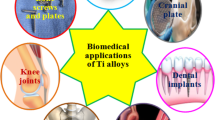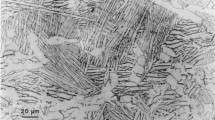Abstract
This chapter provides an overview of surface modification of titanium alloy for applications in aerospace, automotive, and biomedical field. Current uses for titanium alloys are found in biomedical, automotive, aerospace, and other industrial applications. For aerospace uses, titanium alloys can be used for about 70% of the total, including engine components and airframe structures. Titanium alloys provide a notable advantage in several industrial applications, including heat exchangers, cooling systems in power stations, and chemical industries. In recent times, titanium alloys have been used in oil and gas drilling industries. It was observed that surface degradation of titanium alloy was observed in all the above applications after a certain amount of time or cycle. To enhance the surface properties of titanium alloy, surface engineering of titanium alloy with the appropriate surface modification technique is essential. The present trends predicted that industrial and commercial segments of titanium alloys could triple in the next five years. This chapter presents several case studies involving surface engineering techniques used for titanium alloys for potential automotive, biomedical, and aerospace applications. The demand for applications like the aerospace, biomedical, and automotive industry of titanium alloy boosts the ever-increasing demands for improving the surface modification of titanium alloys to meet the various needs. However, these alloys cannot possess all the desired attributes, especially important surface properties like wear and corrosion resistance. Therefore, surface modification techniques have to be used to enhance surface properties and satisfy the specific needs for various applications. This chapter discusses various surface modification methods used for titanium alloys to protect them from degradation. Titanium and titanium alloys can be extensively used in biomedical components and devices, especially in cardiac and cardiovascular applications, as hard tissue replacements. However, titanium alloys cannot meet all clinical requirements. Surface modification is often required to improve the biological, chemical, and mechanical properties. The present chapter also highlights the various surface modification techniques pertaining to titanium alloys, including thermal spraying, sol–gel, electrochemical treatment, and ion implantation from biomedical engineering. The present study focuses on improving the surface properties of titanium alloy for better wear resistance, corrosion resistance, and other biological properties using appropriate surface modification techniques while the desirable bulk attributes are retained.
Access this chapter
Tax calculation will be finalised at checkout
Purchases are for personal use only
Similar content being viewed by others
References
Miller PD, Holladay JW (1958) Friction and wear properties of titanium. Wear 59:133–140
Thomas M, Lindley T, Rugg D et al (2012) The effect of shot peening on the microstructure and properties of a near-alpha titanium alloy following high temperature exposure. Acta Mater 60:5040–5048
Chen X, Zhu R, Gao H et al (2020) A high bioactive alkali-treated titanium surface induced by induction heat treatment. Surf Coat Technol 385:125362
Pierlot C, Pawlowski L, Bigan M et al (2008) Design of experiments in thermal spraying: a review. Surf Coat Technol 202:4483–4490
Urlea V, Brailovski V (2017) Electropolishing and electropolishing-related allowances for powder bed selectively laser-melted Ti-6Al-4V alloy components. J Mater Process Technol 242:1–11
Farias A, Batalha GF, Prados EF et al (2013) Tool wear evaluations in friction stir processing of commercial titanium Ti-6Al-4V. Wear 302:1327–1333
Poltavtseva VP, Ghyngazov SA, Satpaev DA (2012) The influence of high-energy krypton ion implantation temperature on structure and properties of Ni–Ti alloy. Russ Phys J 61:2012–2018
Zaguliaev D, Gromov V, Rubannikova Y et al (2020) Structure and phase states modification of AL-11SI-2CU alloy processed by ion-plasma jet and pulsed electron beam. Surf Coat Technol 383:125246
Okipnyi IB, Maruschak PO, Zakiev VI et al (2014) Fracture mechanism analysis of the heat-resistant steel 15Kh2MFA(II) after laser shock-wave processing. J Fail Anal Prev 14:668–674
Wu LK, Wu JJ, Wu WY et al (2020) Sol–gel-based coatings for oxidation protection of TiAl alloys. J Mater Sci 55:6330–6351
Hussein M, Adesina A, Kumar M et al (2019) Investigations of in vitro corrosion, and wear properties of TiN PVD coating on Ti6Al4V alloy for dental application. Key Eng Mater 813:1–6
Grenadyorov AS, Solovyev OKV et al (2020) Modifying the surface of a titanium alloy with an electron beam and a-C:H:SiOx coating deposition to reduce hemolysis in cardiac assist devices. Surf Coat Technol 381:125113
Konovalov S, Osintsev K, Golubeva A et al (2020) Surface modification of Ti-based alloy by selective laser melting of Ni-based superalloy powder. Integr Med Res 9:8796–8807
Matli PR, Krishnan AV, Manakari V et al (2020) A new method to lightweight and improve strength to weight ratio of magnesium by creating a controlled defect. J Mater Res Technol 9:3664
Basheer AA (2020) Advances in the smart materials applications in the aerospace industries. Aircraft Eng Aero Technol 92:1027e35
Malahayati M, Yufita E, Ismail I et al (2021) Hydrogen desorption properties of MgH2 + 10 wt% SiO2 + 5wt% Ni prepared by planetary ball milling. Bull Chem React Eng Catal 16:280e5
Salleh EM, Ramakrishnan S, Hussein Z (2016) Development of biodegradable Mg-Ti alloy synthesized using mechanical alloying. Adv Mater Res 1133:75e9
Berglund IS, Brar HS, Dolgova N et al (2012) Synthesis and characterization of Mg-Ca-Sr alloys for biodegradable orthopedic implant applications. J Biomed Mater Res B Appl Biomater 100:1524e34
Howie DW (1990) Implant-bone interface. Springer, London
Samuneva B, Kozhukharov V, Trapalis C et al (1993) Sol-gel processing of titanium containing thin coatings. J Mater Sci 28:2353
Trapalis C, Kozhukharov V, Samuneva B, Stefanov P (1993) J Mater Sci 28:1276
Dieudonne SC, van den Dolder J, de Ruijter JE et al (2002) Osteoblast differentiation of bone marrow stromal cells cultured on silica gel and sol-gel-derived titania. Biomaterials 23:304
Kim HW, Kim HE, Knowlesb JC et al (2004) Hydroxyapatite/poly (ε-caprolactone) composite coatings on hydroxyapatite porous bone scaffold for drug delivery. Biomaterials 25:3351
Baek SH, Choi Y, Choi W (2015) Large-area growth of uniform single layer MoS2 thin films by chemical vapor deposition. Nano res lett 10:388
Ianno NJ, Dillon RO, Ali A (1995) Deposition of diamond-like carbon on a titanium biomedical alloy. Thin Solid Films 270:275
Khor KA, Yip CS, Cheang P (1997) Ti-6Al-4V/hydroxyapatite composite coatings prepared by thermal spray techniques. J Therm Spray Technol 6:109
Chang E, Chang WJ, Wang BC et al (1997) Plasma spraying of zirconia-reinforced hydroxyapatite composite coatings on titanium: part I phase, microstructure and bonding strength. J Mater Sci Mater Med 8:193–200
Khor KA, Cheang P, Wang Y (1998) Plasma spraying of combustion flame spheroidized hydroxyapatite (HA) powders. Therm Spray Technol 7:254
Silva PL, Santos JD, Monteriro FJ et al (1998) Adhesion andmicrostructural characterization of plasma-sprayed hydroxy-apatite/glass ceramic coatins onto Ti-6Al-4V substrates. Surf Coat Technol 102:191–196
Wang Y, Khor KA, Cheang P (1998) Thermal spraying of functionally graded calcium phosphate coatings for biomedical implants. J Therm Spray Technol 7:50
Tsui YC, Doyle C, Clyne TW (1998) Plasma sprayed hydroxyapatite coatings on titanium substrates. Part 1: mechanical properties and residual stress levels. Biomaterials 19:2015
Uhlmann E, Kersting R, Borsoi T (2015) Additive manufacturing of titanium alloy for aircraft components. Procedia CIRP 35:55–60
Matsubara T, Sato Y, Kimura K et al (1991) HONDA R&D Tech Rev 3:12–26
Kubota T, Takahashi K (2018) Bull Iron Steel Inst Jpn 23:585–590
Wagner L, Schauerte O (2007) Ti-2007 science and technology. Jpn Inst Metals:1371–1378
Kosaka Y, Fox SP, Faller K (2007) Ti-2007 science and technology. Jpn Inst Metals:1383–1386
Hatem A, Lin J, Wei R et al (2018) Tribocorrosion behavior of low friction TiSiCN nanocomposite coatings deposited on titanium alloy for biomedical applications. Surf Coatings Technol 347:1–12
Schroeder V, Gilbert CJ, Ritchie RO (1998) Comparison of the corrosion behavior of a bulk amorphous metal, Zr41.2Ti13.8Cu12.5Ni10Be 22.5, with its crystallized form. Scr Mater 38:1481–1485
Bansal P, Singh G, Sidhu HS (2021) Improvement of surface properties and corrosion resistance of Ti13Nb13Zr titanium alloy by plasma-sprayed HA/ZnO coatings for biomedical applications. Mater Chem Phys 257:123738
Jiang J, Han G, Zheng X et al (2019) Characterization and biocompatibility study of hydroxyapatite coating on the surface of titanium alloy. Surf Coatings Technol 375:645–651
Yuan S, Lin N, Zou J et al (2020) In-situ fabrication of gradient titanium oxide ceramic coating on laser surface textured Ti6Al4V alloy with improved mechanical property and wear performance. Vacuum 176:109327
Zhao Y, Lu M, Fan Z et al (2020) Laser deposition of wear-resistant titanium oxynitride/titanium composite coatings on Ti-6Al-4V alloy. Appl Surf Sci 531:147212
Lu XL, Liu XB, Yu PC et al (2016) Synthesis and characterization of Ni60-hBN high temperature self-lubricating anti-wear composite coatings on Ti6Al4V alloy by laser cladding. Opt Laser Technol 78:87–94
Author information
Authors and Affiliations
Corresponding author
Editor information
Editors and Affiliations
Rights and permissions
Copyright information
© 2023 The Author(s), under exclusive license to Springer Nature Singapore Pte Ltd.
About this chapter
Cite this chapter
Suresh, G., Ramesh, M.R., Srinath, M.S. (2023). Surface Engineered Titanium Alloys for Biomedical, Automotive, and Aerospace Applications. In: Vignesh, R.V., Padmanaban, R., Govindaraju, M. (eds) Advances in Processing of Lightweight Metal Alloys and Composites. Materials Horizons: From Nature to Nanomaterials. Springer, Singapore. https://doi.org/10.1007/978-981-19-7146-4_5
Download citation
DOI: https://doi.org/10.1007/978-981-19-7146-4_5
Published:
Publisher Name: Springer, Singapore
Print ISBN: 978-981-19-7145-7
Online ISBN: 978-981-19-7146-4
eBook Packages: Chemistry and Materials ScienceChemistry and Material Science (R0)




